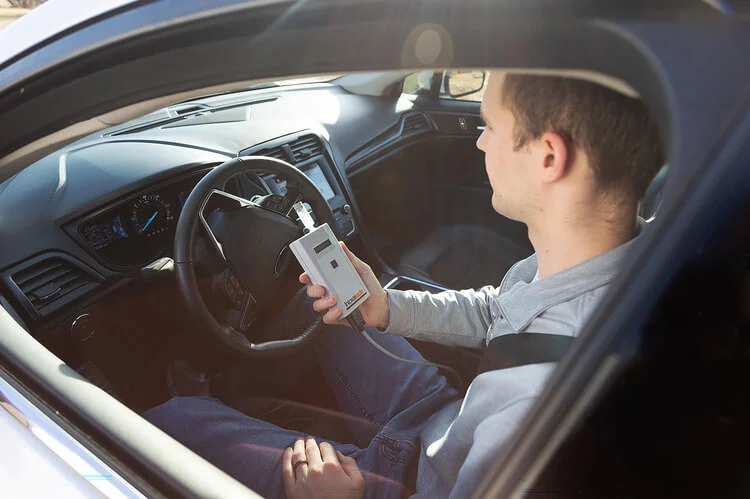Avoiding Contaminants: 9 Potential Triggers for Ignition Interlock Beyond Alcoholic Drinks
When using an ignition interlock device (IID), or car breathalyzer, passing each breath test is critical to keeping your driving privileges. IID tests are designed to detect alcohol, which is why factors like the food you eat to environmental conditions or personal care products that contain alcohol can result in a positive reading, leaving users confused and frustrated.
In this guide, we’ll explore the potential reasons behind unexpected results and provide tips on how to avoid them, helping you stay compliant and stress-free.
Understanding Ignition Interlock Device Contaminants
A contaminant may cause your ignition interlock device to detect alcohol or another interfering substance, even if you haven’t consumed alcohol. While this isn’t a common occurrence, it’s important to understand what might cause these readings. Factors like certain foods, personal care products, and environmental conditions can all play a role in contaminating the results of your IID test. By identifying these factors, you can take steps to avoid contaminants and ensure that your driving privileges remain unaffected.
Ignition Interlock Device Accuracy
How accurate are ignition interlock devices?

Ignition interlock devices are highly accurate and designed to detect even small traces of alcohol. They use advanced fuel-cell technology, which reacts specifically to alcohol molecules in your breath. However, certain unexpected sources of alcohol, or compounds that mimic alcohol, can occasionally interfere with the results. While these instances are rare, it’s helpful to be aware of them so you can take steps to avoid an unexpected, failed interlock test. With proper care and attention, you can maintain the accuracy of your car breathalyzer and avoid any complications.
“False Positive Readings”
In some cases, people describe certain breathalyzer results as a "false positive" or a "contaminated positive reading." However, there’s nothing false about it. While the reading may indicate the presence of other types of alcohol (examples: mouthwash or medications), the device is accurately identifying alcohol’s presence.
Common Substances That Can Trigger a Positive Reading (Besides the Consumption of Alcoholic Beverages)
Although car breathalyzers are designed to detect alcohol that’s typically in drinks, there are several other chemical sources that can trigger a positive reading. These can range from everyday foods and drinks to personal care products and even environmental elements. Here are some of the most common culprits:
Foods and Drinks That May Cause Positive Readings
What you consume can sometimes lead to a failed IID test, especially if it contains small amounts of alcohol or triggers a reaction in your body. Understanding how certain foods and drinks might affect your results is crucial to avoiding unnecessary lockouts or penalties. Here are a few factors to consider that affect whether certain foods or drinks could unexpectedly trigger a positive reading due to a contaminant:
What You Ate or Drank Prior
Some foods, particularly those that ferment or contain small amounts of alcohol, can trigger a positive reading. For example, bread, pastries, and ripe fruit can produce trace amounts of alcohol as they break down, which may be detected by your IID. Similarly, fermented beverages like kombucha may contain small levels of alcohol, even if labeled as non-alcoholic.
Your Body Weight
Your body weight plays a role in how your body processes alcohol. If you have a lower body weight, alcohol or even trace substances that mimic alcohol may linger longer in your system, leading to a higher breath test reading.
Your Metabolism Rate
Individuals with slower metabolism rates may take longer to eliminate alcohol or alcohol-like substances from their systems. This can affect how quickly you return to a “clean” reading after consuming something that could trigger your IID.
Your Gender
Gender can also influence how your body processes alcohol. Women, for example, often metabolize alcohol differently than men, which can lead to variations in test results, even if both consumed the same amount of alcohol or were exposed to the same substances.
Personal Care Products That Can Interfere with Your IID
Personal hygiene products often contain alcohol or other chemicals that can interfere with your breathalyzer. While using these products is an essential part of daily life, it’s important to recognize which ones may pose a risk to your IID test. Here are a few to be cautious of:
Mouthwash or Breath Sprays
Many mouthwashes and breath sprays contain alcohol. If you’ve recently used these products, they can leave trace amounts of alcohol in your mouth that may skew your breath test results. To avoid this, consider using alcohol-free versions of these products or waiting a minimum of 15 minutes after use before taking your IID test.
Medications or Over-the-Counter Drugs
Certain medications, particularly those in liquid form, may contain alcohol. For instance, cough syrups, liquid cold medicines, and asthma inhaler propellants may all include alcohol as a preservative or solvent. If you’re taking any medication, it’s a good idea to check the label for alcohol content and consult with your doctor about alcohol-free alternatives if necessary.
Your Health Conditions
Certain health conditions, such as acid reflux or diabetes, can produce substances in your breath that may trigger a positive reading on your IID. For example, individuals with diabetes may produce acetone in their breath, which can be misinterpreted by the device as alcohol. If you have a medical condition that may affect your IID test, it’s important to discuss it with your doctor and your IID provider to avoid complications.
Environmental Factors That Can Trigger a Positive Result
Your surroundings can also play a role in triggering a positive IID test result. From environmental conditions to exposure to certain chemicals, it’s important to be mindful of where and when you take your breath test. Here are a few key factors to consider:
Temperature and Altitude
Extreme temperatures or high altitudes can sometimes affect breath test readings. This is due to the way alcohol vapor behaves in different atmospheric conditions. If you’re in a particularly cold or hot environment or at a high altitude, it’s best to let your car adjust to normal temperatures before testing.
Chemical Fumes (such as hand sanitizer, perfume/cologne)
Fumes from products like hand sanitizers, perfumes, and colognes often contain alcohol. If you’ve recently used hand sanitizer or sprayed perfume in a confined space like your car, the residual fumes could interfere with your breath sample. To prevent this, make sure the area is well-ventilated before taking your test, and avoid using these products immediately beforehand.
How to Avoid Positive Readings Due to Contaminants

How can I reduce the chance of a positive reading due to a contaminant?
Avoiding contaminants while using an IID requires being mindful of what you consume, the products you use, and the environment you’re in before taking your IID test. Here are a few tips to help you avoid positive readings caused by contaminants:
- Wait at least 15 minutes after eating or using any personal care products (especially those containing alcohol) before taking your test.
- Rinse your mouth with water before testing to clear out any residual substances that may affect the results.
- Avoid exposure to chemical fumes right before your breath test by keeping your car ventilated and ensuring your hands are dry if using hand sanitizer.
By following these steps, you’ll significantly reduce your risk of triggering a positive reading and ensure that your IID operates as intended.
What to Do After a Failed or Incorrect Breath Test
If you believe your IID test result is incorrect, it’s important to act quickly and responsibly. Here are answers to some common questions:
What should I do if I think my breath test results are incorrect?
If you receive a failed test result that you believe is incorrect, immediately rinse your mouth with water and retest after a short wait. If the issue persists, contact Intoxalock customer service for further assistance.
How long should I wait before I retest?
After a failed breath test, it’s recommended to wait at least 15 minutes before retesting to ensure any residual substances are cleared from your breath.
How many failed IID tests are allowed?
Each state has its own regulations regarding the number of failed tests allowed before consequences are applied. However, multiple ignition interlock failed tests can lead to penalties such as lockouts or reporting to authorities, so it’s crucial to avoid them when possible.
What are the consequences for a failed breath sample?
Consequences for a failed breath sample can vary by state but typically include a lockout period where you cannot start your vehicle. In some cases, the failed interlock test may be reported to the court or state monitoring authorities, leading to further penalties or requirements.
Why Choose Intoxalock?
Call Intoxalock today to get the reliable support you need for your ignition interlock device program. Intoxalock offers easy-to-use, accurate devices backed by trusted fuel-cell technology. With over 5,500 locations nationwide, we provide convenience and 24/7 customer support to guide you through every step. Our transparent pricing means no surprises, and our specialists are always available to answer questions or help you avoid positive readings that are caused by contaminants. Contact us now to speak with a state specialist and drive again today!
If you have more questions about avoiding contaminants or need assistance with your IID, contact us now to speak with one of our state specialists. We’re here to help you succeed in your IID program and get back on the road with confidence.





